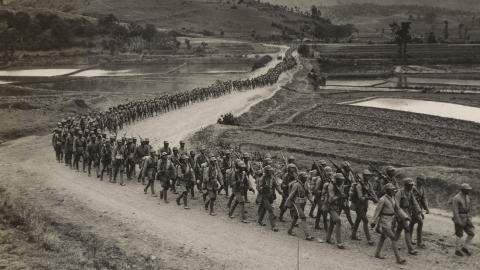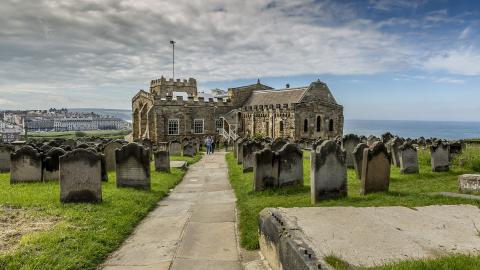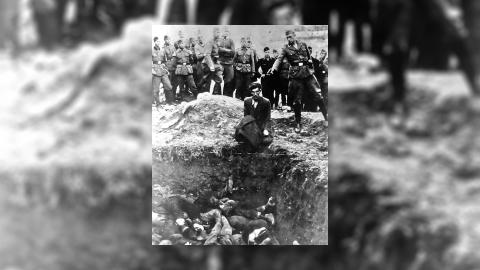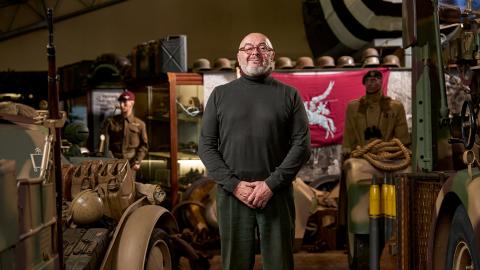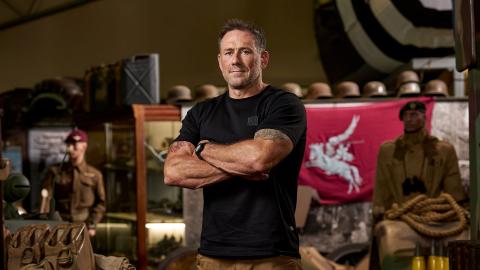The A to Z of WW2 Treasure Hunting
On HISTORY's WW2 Treasure Hunters, Madness frontman Suggs heads out to find some of the best relics left behind from the war, but he's not alone. Luckily for him, he's got one of the UK's leading relic hunters alongside, Stephen Taylor. Doing this for over twenty years, Stephen has an unparalleled knowledge of what it takes. We caught up with him to find out exactly what a relic hunter is, what it takes to be one and why he's so into it.
HISTORY: Hi Stephen! Can you tell us a bit about WW2 Treasure Hunting?
Stephen: A WW2 Treasure Hunter is someone who goes around looking for relics left behind by the airforce, the army, the Navy, even prisoners of war of WW2. Treasure Hunters, like me, do an awful lot of research into various old army camps and air bases and determine if they are going to be worth searching. If they are, we go out and try and find some relics.
Is there a lot of stuff out there?
A hell of a lot of stuff was left behind from WW2, people just don't realise it. I often say to people if you go to the location of an old American airforce base I can guarantee at some point you will be standing on live ammunition. They scattered it like confetti. Remember there were over a thousand airfields in the UK during the war, it was said that you couldn't walk six miles in any direction from any point in the UK without walking across an airfield.
How did you get into WW2 treasure hunting?
About twenty years ago I went on holiday to Normandy with my family and I spent the whole week dragging them into WW2 museums! On the very last day, I was sat on a sea wall with my son and he jumped down and ran towards the surf. He picked up something, I couldn't see what, and brought it back to me. When he opened his hand he had a cartridge case. I was amazed. He'd given me something that the last person to touch it was someone involved in the greatest seaborne invasion that there has ever been. This thing had real history behind it. It suddenly opened my eyes to the fact that there is an awful lot of history out there that is just buried beneath the surface. Three months later I had my first metal detector.
What about the techniques you use?
The normal technique is you identify a site that hasn't got a modern use that hasn't been built on, then you identify the landowner and get permission to dig. Once you've done that you start researching the area itself and determining where's best to search. Then you turn up with your metal detector and get digging!
Do landowners usually let you dig?
Yeah, most of them are. I haven't been refused permission for around five years.
What have you learnt in making this programme with HISTORY?
What this programme has done is open my eyes to the value of having actual archaeologists with you. I'm not an archaeologist and I don't like to be described as one because I'm not one. I'm a WW2 Relic Hunter. But the archaeologists have really opened my eyes to show me the value of context and the importance of recording things in an accurate way.
As time goes on do you think these objects, left behind from the war, will be key to tell the story of WW2?
Absolutely. remember it's not just about the military kit, bombs, grenades, artillery shells, it's also the personal stuff that was left behind. So when I find a toothpaste tube that gives us an indication as to how that person lived. The amount of Brylcreem that is in the fields out there is astronomical!
What other everyday things do you find?
Brylcreem, Marmite and Bovril! We went through tonnes of the stuff.
Did you enjoy making the series?
Yeah, it's been great filming a television series like this. I really think we'll get the message across to people that this history is still out there, it just needs recovering.
Do these objects change the way we think about history?
I guarantee you that on every site I search I will find an item and at first I will have no idea why its there. For example, on an airbase in the series, I found lots of female things, like perfume puffers and nail polish tins. I couldn't work out what they were doing there. Then you think, in actual fact, every base had WAFS (Women Auxiliary Airforces) and these were their objects. We now have a more interesting and informed story. It adds a great bit to the history.
WW2 Treasure Hunters is currently airing on HISTORY Monday nights at 9pm, find out more here.
Enjoyed this article? Like HISTORY on Facebook or follow us on Twitter for more.

